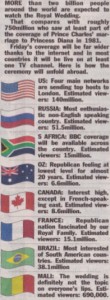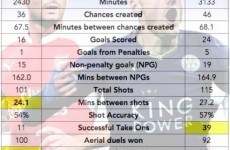- 0
By Nick Harris
SJA Internet Sports Writer of the Year
26 April 2011
I’m not certain who started it, although Culture Secretary Jeremy Hunt had a role in spreading the myth that the Royal Wedding on Friday will be watched by a global audience of 2 billion people.
Hunt even cited this figure of 2bn to a meeting of the Cabinet of the British Government on 6 April this year. (If a Government minister can spout such nonsense to others who help him run the country, you do wonder what else they’re getting wrong, but that’s another story).
Getting back to the claim the wedding will be watched by 2bn. It won’t. And that number is not even good guesswork.
It’s unsubstantiated garbage, as are so many numbers that have been bandied around for global TV audiences for ‘major’ occasions down the years.
It’s easy to see how this happens. Big numbers confuse many people, who don’t engage their brains to ask “Is this true?”.
Journalists far too often swallow what they’re told.
And vested interests like to spread the idea that their ‘product’ (their event or show or whatever it is) is much more popular than in fact it is.
Many of the supposedly “most watched” events in history have been attributed viewing figures that were simply made up. And these numbers are passed down as fact, unquestioned.
It was said that 750m watched the 1981 wedding of Prince Charles and Lady Diana. It’s even in the Guinness Book of Records. And it’s wrong.
If every single person in the world with access to TV in 1981 had watched the Charles-Diana wedding then it might have been something like that. But of course they didn’t. The true figure was probably closer to 100m people.
It was said 2.4bn or 2.5bn watched the funeral of Diana. They didn’t. It might have been about 10th of that figure.
It was said that a Premier League ‘clash of the titans’ match between Manchester United and Arsenal in November 2007 would draw an audience of 1bn globally. The true figure was that 8m people watched the whole match live around the world (1.477m of them in the UK), and 27m people watched at least part of the game. Or in other words, one 37th of the reported audience actually tuned in.
How do we know this? Because there are authoritative and respected measurement bodies who collate this data. They include BARB in the UK and Nielsen in the USA, and TAM in India and equivalent bodies elsewhere.
Kevin Alavy, a director at Future Sports + Entertainment, an arm of leading international analysts Initiative, has spent years compiling accurate, verifiable data about major events from all the world’s major TV markets. In an industry awash with hype, Alavy’s work has been refreshingly bullshit-free.
“Figures like 750m for the wedding of Charles and Diana just aren’t based on any hard data at all,” he tells me. “And it’s completely and utterly ludicrous to suggest that William and Kate’s wedding will get anything like 2bn watching on TV.
“You only need to look at the global broadcasting distribution to see it won’t happen. The Olympic Games and the World Cup (in football) are probably the only events that get screened by the major broadcasters in literally 200 or more countries, and mostly on free-to-air TV, as opposed to on news channels, subscriptions channels and other minor outlets.
“The Royal Wedding will be available on a lot of major channels, of course, but it’s just not in the same league as those biggest sports events, which are the biggest events of any genre.”
Sport bodies and sports broadcasters have been notorious exaggerators over the years, even when their events have been popular anyway. Football’s world governing body Fifa spent years claiming audiences of more than 1bn for the quadrennial World Cup final and cumulative audiences of tens of billions for single tournaments.
After being asked to justify this nonsense in 2007, Fifa admitted some numbers were guesstimates and others just made up. “We are going to steer clear of estimating, and publish data from audited measurement systems only [from now on],” a spokesman told me during an investigation for The Independent into whether viewing numbers had been inflated to help inflate the cost of sponsorship deals.
That same investigation looked at how claims of a 1bn global audience for the Super Bowl were wrong (100m was closer), how a claim of a 2bn audience for the Winter Olympics of 2006 was more than 1.9bn OTT (reality: 87m), and how a claim of a 1.5bn audience for the Commonwealth Games opening ceremony in Melbourne was wrong by a factor of 300 – actually 5m were watching! More examples can be found in the table at the bottom of the piece linked here.
The irony in Fifa’s over-claiming is that the World Cup final is consistently one of the most-watched events on the planet. Something in the region of 250m-300m have watched the last five World Cup finals (2010, 2006, 2002, 1998, 1994), in their entirety, on TV in their own homes. This is the “average” viewership.
Somewhere between 500m and 750m (“the reach”) watched at least part (at least three minutes) of those finals. These are staggeringly good numbers, but perhaps Fifa felt the need to inflate them because everyone else was doing it to a greater degree.
The verifiably most-watched event in human history – and the only “genuine 1bn” event to date – was the opening ceremony of the 2008 Olympic Games in Beijing. I wrote about this here in the Sunday Times in 2009.
The “average” audience (those watching the four-hour event whole) was 593m people, many of them within host nation China, the world’s most populous country. China’s 1.3bn population was why the event was so popular. Only 5m people, for example, watched the same event in Britain.
In all, 984m people around the world tuned in for part of that opening 2008 Games ceremony via TV in their own homes, and the 16m balance needed to get to 1bn was almost certainly achieved by people watching around the world in public places.
For all China’s success in 2008, it would be wrong to assume that any major event in a country with a massive population will translate into a world-beating TV audience. The cricket World Cup of 2011, which culminated with two co-hosts in the final on 2 April, and with India beating Sri Lanka to win, did not come close to match the Beijing ceremony.
Kevin Alavy’s best guess on the data available is that the “reach” globally for the India-Sri Lanka match was probably no more than 400m people, and the vast majority of those people were in India, where the population is 1.2bn.
In fact figures from TAM in India – official figures – show that a maximum audience of 135m watched the final in India on TV, with an average of 67.6m watching for the full four hours. Even so, these were records for Indian TV. (The cricket World Cup final attracted an audience of 635,000 in the UK on Sky, a figure that can be checked on the BARB website for that channel. In the same weekend, 762,000 watched Fulham v Blackpool in the Premier League, and 1,163,000 watched Man City v Sunderland).
When people make historic claims about any TV audience prior to the 1980s, they often forget that virtually nobody in Asia owned a TV before then (one in a hundred households in China in the late 1970s for example, fewer in India, and that’s almost half the planet’s population in two countries).
Even today, only around half of India’s households own a TV set. This figure is lower than 20 per cent in some of the poorest states. And those households that do own TVs tend to be richer, and therefore smaller in number. So in fact only around 450m Indians of 1.2bn have access to a TV set at home.
But back to the wedding, and those 2bn people who will supposedly be watching Prince William (president of the FA and famous Aston Villa fan, no less) marry Kate.
 There was an interesting little story in yesterday’s Sun newspaper, repeating the “more than two billion people” claim. (See scan of paper, left, click to enlarge). The Sun also bravely tried to show where some of those 2bn would come from, including 140m viewers in the USA, 51.5m in Russia and 690,000 people in Mali.
There was an interesting little story in yesterday’s Sun newspaper, repeating the “more than two billion people” claim. (See scan of paper, left, click to enlarge). The Sun also bravely tried to show where some of those 2bn would come from, including 140m viewers in the USA, 51.5m in Russia and 690,000 people in Mali.
Rubbish.
If we just consider the USA estimate, of 140m people, that would mean this Friday’s wedding would eclipse the most-watched TV show in American history (the 2011 Super Bowl, which attracted 111m viewers in the USA), by 29m people.
That’s not going to happen. Nothing like it. Especially not when the wedding is starting at 6am East Coast time in the USA, and 3am West Coast.
And even if we add up the numbers supposedly going to watch in the eight countries cited by the Sun, three of them among the top nine* in the world in population – the US*, Russia*, South Africa, Australia, Canada, France, Brazil* and Mali – then you get a figure of 275.59m people.
So where are the other 1.724bn watching from?
Answer: they’re not. And neither are the 275m going to materialise. It’s made up! Out of nothing!
But as Kevin Alavy tells me: “The figure of 2bn is out there now, somehow, and probably it’s going to be the one that’s accepted, and believed, even though it’s made up on the basis of no credible evidence whatsoever.”
Still, a good excuse for a day off and party, no?
[ADDED on 9.5.11 – Read the follow-up on 9 May, and the real figures by clicking here]
.









